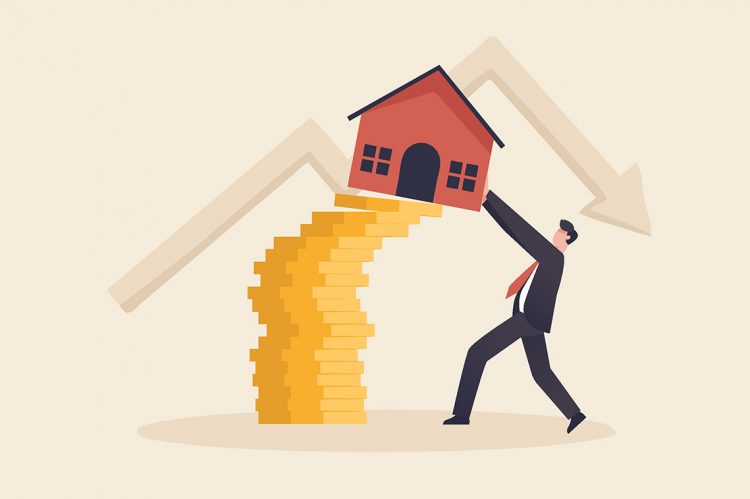Most can agree that the housing affordability crisis has been a thorn in the side of many consumers in recent years—the pandemic-influenced housing boom saw to that. That problem could see some changes as experts think the market correction could bring a mix of factors that ultimately improve affordability.
“We see 2023 as a giveback year in some sense from the huge years that the second half of 2020 through the first half of 2022 was for the real estate industry,” says Doug Duncan, Fannie Mae’s chief economist. “Those were huge years, so 2023 after the Fed tightening is really a year of giveback, and we think starting in 2024, we will start seeing a gradual recovery in housing.
However, there are a few caveats, according to Fannie Mae forecasters, who expect the road to a housing market “recovery” will make its way through a recession.
Duncan and Mark Palim, deputy chief economist at Fannie Mae, spoke with RISMedia recently to delve into the agency’s latest predictions for the housing market over the coming 24 months, which include projections of price declines, dips in home sales and a “mild recession” sometime in the first half of 2023.
“We have thought for some time that as the Fed tightened, we would expect to see a recession,” Duncan says.
According to Duncan, the expected mildness of the recession is mainly due to the housing market, which he says is behaving as it has always done when the Fed tightens.
After arguably the best years of sales activity the industry has experienced, home sales are expected to drop by more than 21% this year—roughly 4.5 million units sold—based on Fannie Mae’s predictions. Despite the decline, forecasters anticipate a rebound by the end of next year, with sales climbing 12.8% to 5.1 million units.
“This is a pace still well below recent years as affordability challenges remain elevated,” Fannie Mae stated in its forecast.
Home prices are also slated to decline after Fannie Mae revised its forecasts for 2023 and 2024. Price tags for homes are expected to drop 4.2% by the end of the year, followed by 2.3% in 2024. Fannie Mae had initially anticipated a milder dip.
While there is likely to be some variance to the price drops based on the markets, Fannie Mae is expecting an overall reduction of about 10% in the average home price over the next two years.
“One of the reasons they think that is rational is because of supply,” Duncan says, adding that the inventory will remain a key factor influencing the price changes for years to come.
With the supply of existing homes for sale still tight, forecasters “do not anticipate an overabundance of properties on the market leading to disorderly home price declines.”
Instead, Fannie Mae’s report suggests that weaker sales and gradual home price declines will persist until affordability measures “approach more sustainable levels, which would lead to a recovery in transactions.”
Mortgage rates are expected to drift downward over the coming years, with Fannie Mae forecasters projecting rates to dip to just above 6% by the end of 2023 and around 5.5% in 2024.
This isn’t likely to entice existing owners to list their homes for sale and move due to what Fannie Mae described as the “lock-in” effect.
The pandemic brought consumers a mix of opportunities to realize their homeownership goals, with the help of historically low mortgage rates that dipped under 3% in 2020 and held around 3% throughout 2021.
According to Duncan, that phenomenon has sowed the seeds of future headwinds on the supply front, as many folks are locked into their mortgages and won’t have much incentive to move.
“They are going nowhere unless they are forced to, so the supply of existing homes on the market is still incredibly low, and the supply of new homes on the market seems high, but a significant portion of that are lots that haven’t been developed yet,” he says.
According to Duncan, aging in place among baby boomers is another persisting trend that will strain housing stock in the medium to long term.
“The number of people 75-plus over the next 25 years will go from roughly 25 million people to roughly 50 million people, so there is going to be this huge growth,” Duncan says. “The question is will they cycle out of the homes that they own today because the homeownership rate in that group is about 80%? That will be a determining factor.”
Palim believes that remote work and the tech that has facilitated that trend during the pandemic could also have unknown effects on the housing market in coming years.
“To me, remote work will have all sorts of impacts,” he says. “We just saw the initial impacts, which were heavily influenced by pandemic considerations. Now we’ll settle into what this means for labor force participation.”
The future of the housing market recovery and the economy also hinges to a large degree on the Federal Reserve, according to Palim.
“The housing market has had to take the brunt of the Fed’s tightening and monetary policy and unemployment while it lags still at 3.5%, which is well below the level that you would expect even in a mild recession and is a very tight labor market,” Palim explains. “That may cause the Fed to be more aggressive, or they’ve already done damage that we don’t see yet.”
Duncan believes that forecasters are likely betting on Fed officials holding interest rates at their peak for an extended period, despite retractions in inflation. At the same time, some may expect the Fed to ease up on rate hikes in the second half of 2023.
“We have built some of that into our forecasts partly because if there is a recession, the long end of the yield curve will likely come down irrespective of what the Fed does,” Duncan says. “We are kind of weakening that bet on whether Powell will hold as long as he says he will. If he were to hold rates at their peak through the full year 2023, then that would likely delay our timing of the recovery in housing by four to six months. So 2024 would be weaker at the outset than what we currently have in the forecast.”












